#Red Hat Learning Subscription
Explore tagged Tumblr posts
Text
[Akuneko Tips & Manual]
Three Bar Menu (Part One)
Manual Masterlist

When you click on the three bars menu, this page will pop open, you can change your information or setting on here at any time.

Items/Tickets you have (Inventory)

Page 1
Butterfly dias: Used in gacha to get SSR cards or SR/R clothes/dias exchange shop for past memories!Below, the numbers indicate: Free butterfly dias and Paid butterfly dias to differentiate.
Purple Orb: Another pity card exchange system, 1100 orbs for the reduced current ongoing gacha card, but for past cards, 1320 orbs. You get the full set of the clothes + SSR card.
SSR confirmed ticket: Only for the paid subscription
Initial SSR confirmed ticket: for the beginner accounts at the very beginning, one confirmed SSR card.
[Special] SSR confirmed ticket: Only for level 6 Paid Subscription bonus.
[Special] 11 pull Gacha ticket: For anniversaries login bonus.
Beginner mission gacha ticket: Complete beginner missions and get one pull gacha tickets.
Exploration Celebration Gacha ticket: for this current limited event to celebrate the new exploration updates with the dolls, if you complete the limited mission, you can get one pull gacha tickets.
Level up keys: you need 12 to level up a card.
Premium ribbons: can be acquired from exchanging in the event exchange shop, and these are used in the premium ribbon shop. In the premium ribbon shop you can exchange keys, voice crystals and anniversary SR cards with voice drama.
Page 2-6
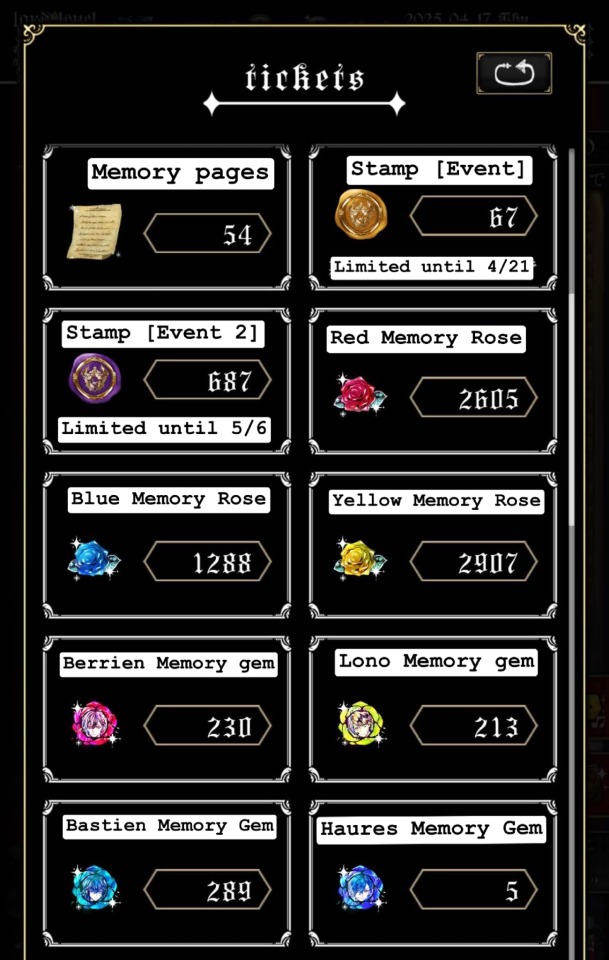
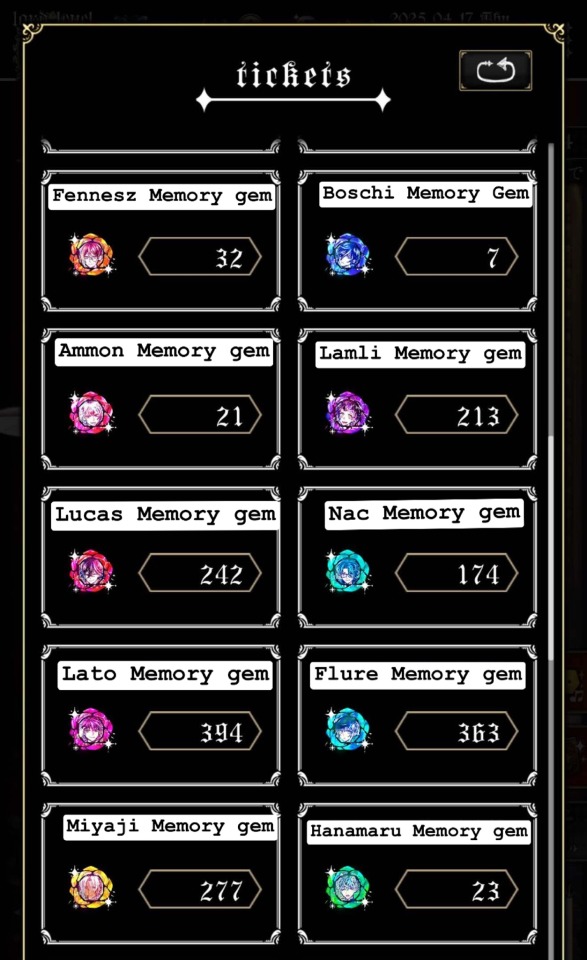
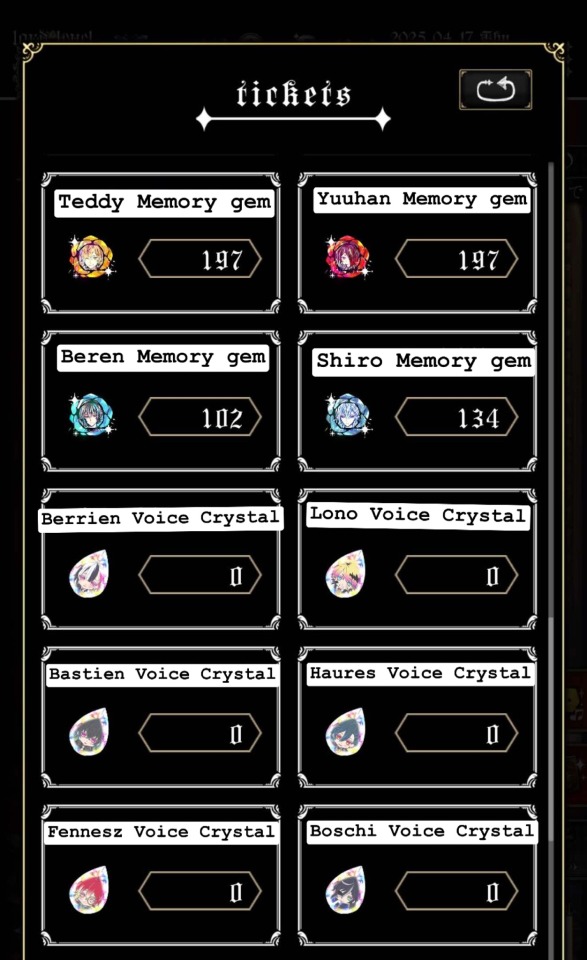

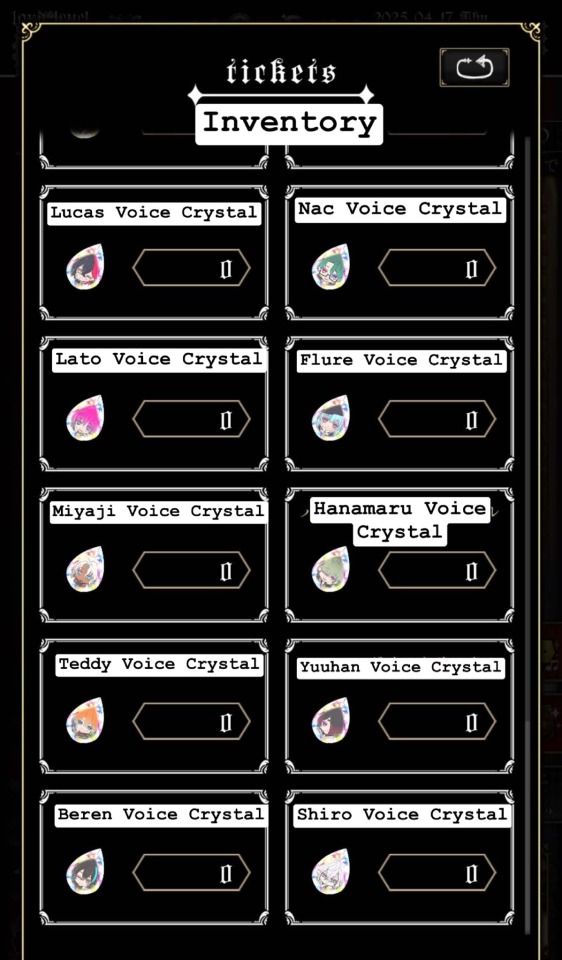
Memory Pages: Used in the Revival Event Exchange Shop. You can use these pages to exchange past event outfits, backgrounds, dolls, hats, Halloween white wig and black hair wig for Miyaji (only for the initial 13 butlers), photo decorations. You get acquire these pages from the random floating items on the main page or exchange them in the event shop.
Event Stamps: These stamps are used in the event shop for items such as Dias, event memories, event outfit, Premium Ribbons, Red/Blue/Yellow Rose Memory Gems, Memory Pages. They are only for a limited time for exchange. You can acquire them from limited event missions (Butler’s Request), mansion exploration and floating randomize rose.
Red/Yellow/Blue Memory Rose Gems: Unlock memories (butler, palace, past login stories) and also roll for the doll gacha! You can get them from explorations and event exchange shop.
Butler Memory Gems: Unlock butler memories with the Rose memory gems. You can get them from explorations (from choosing either first floor, second floor, third floor, basement, villa, Villa second floor), the butler memory gem you get will be in the floor you choose from.
Butler Voice Crystal: Unlock Home Screen conversation lines that are voiced. Used in the Right Side Red Music …function.
Butler Level Learn More
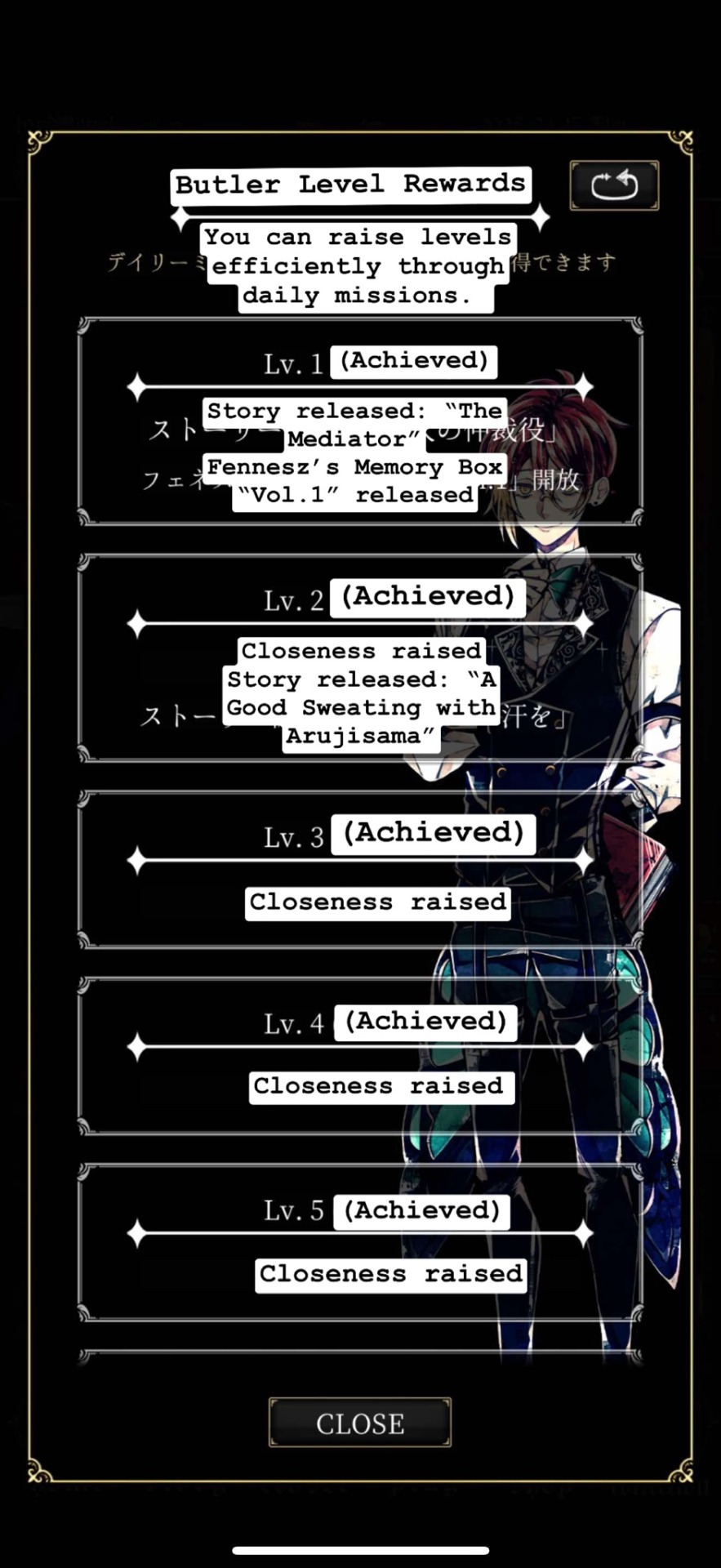
When you press on the Learn more button beside the level, you could open up a menu to see the rewards that comes with each level up. In the initial levels, you can see that in the conversation, the butlers aren’t really close with you, but as the levels go up, around level 4-5, they started to become even closer, the levels 8 and above, they would become really close with you, even trusting you with talking about them.
The same thing happens when you press on the Learn more on Your level too (with each level you raise along with the butler level, you can also get butterfly Dias from the rewards)
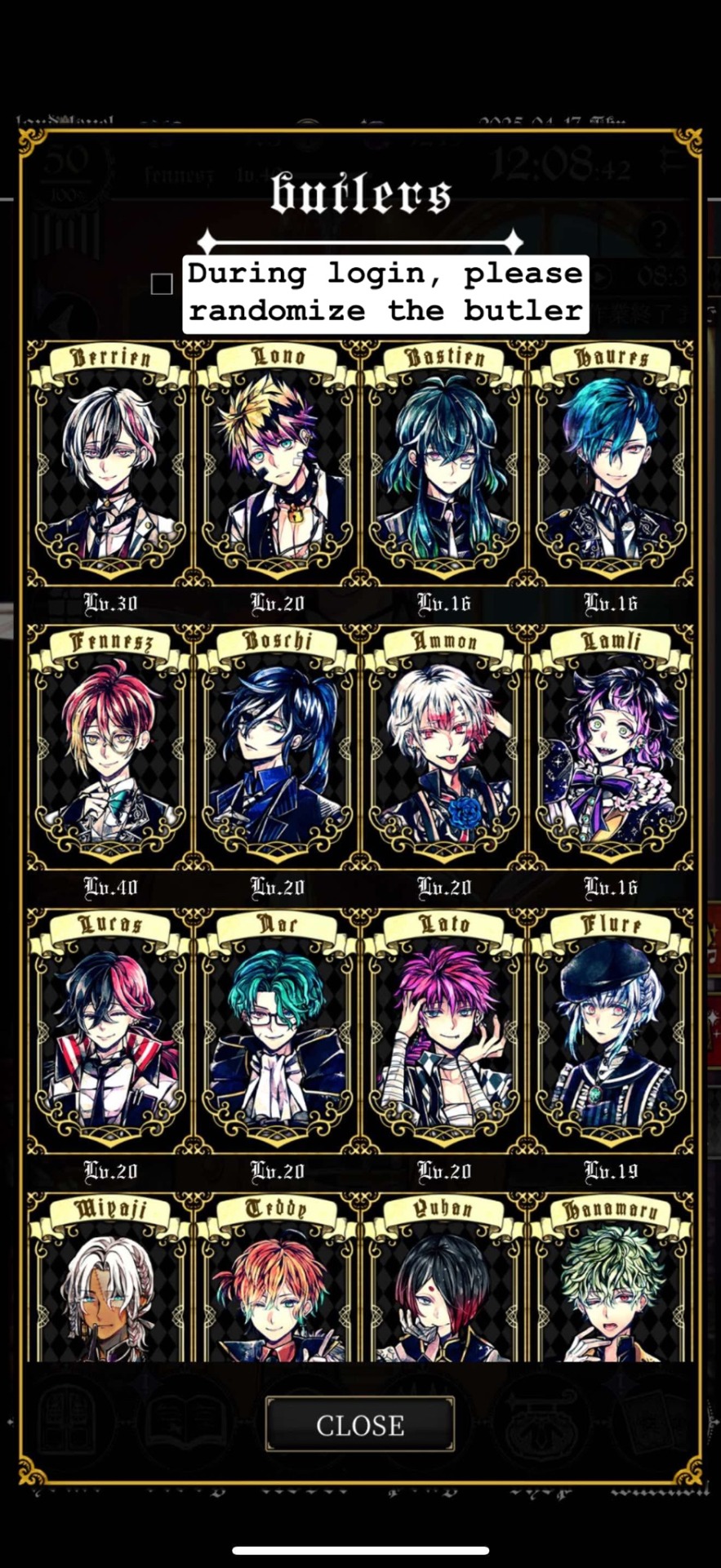
As well, when you press on the All of the Butler option, you can also access the Change Butler page to change to another butler the same way as the arrow bottom we previously went through.
#aknk#akuneko#devil butler with black cat#あくねこ#悪魔執事と黒い猫#Akuneko tutorials#akuneko translations#Akuneko manual
4 notes
·
View notes
Text
🚀 Red Hat Services Management and Automation: Simplifying Enterprise IT
As enterprise IT ecosystems grow in complexity, managing services efficiently and automating routine tasks has become more than a necessity—it's a competitive advantage. Red Hat, a leader in open-source solutions, offers robust tools to streamline service management and enable automation across hybrid cloud environments.
In this blog, we’ll explore what Red Hat Services Management and Automation is, why it matters, and how professionals can harness it to improve operational efficiency, security, and scalability.
🔧 What Is Red Hat Services Management?
Red Hat Services Management refers to the tools and practices provided by Red Hat to manage system services—such as processes, daemons, and scheduled tasks—across Linux-based infrastructures.
Key components include:
systemd: The default init system on RHEL, used to start, stop, and manage services.
Red Hat Satellite: For managing system lifecycles, patching, and configuration.
Red Hat Ansible Automation Platform: A powerful tool for infrastructure and service automation.
Cockpit: A web-based interface to manage Linux systems easily.
🤖 What Is Red Hat Automation?
Automation in the Red Hat ecosystem primarily revolves around Ansible, Red Hat’s open-source IT automation tool. With automation, you can:
Eliminate repetitive manual tasks
Achieve consistent configurations
Enable Infrastructure as Code (IaC)
Accelerate deployments and updates
From provisioning servers to configuring complex applications, Red Hat automation tools reduce human error and increase scalability.
🔍 Key Use Cases
1. Service Lifecycle Management
Start, stop, enable, and monitor services across thousands of servers with simple systemctl commands or Ansible playbooks.
2. Automated Patch Management
Use Red Hat Satellite and Ansible to automate updates, ensuring compliance and reducing security risks.
3. Infrastructure Provisioning
Provision cloud and on-prem infrastructure with repeatable Ansible roles, reducing time-to-deploy for dev/test/staging environments.
4. Multi-node Orchestration
Manage workflows across multiple servers and services in a unified, centralized fashion.
🌐 Why It Matters
⏱️ Efficiency: Save countless admin hours by automating routine tasks.
🛡️ Security: Enforce security policies and configurations consistently across systems.
📈 Scalability: Manage hundreds or thousands of systems with the same effort as managing one.
🤝 Collaboration: Teams can collaborate better with playbooks that document infrastructure steps clearly.
🎓 How to Get Started
Learn Linux Service Management: Understand systemctl, logs, units, and journaling.
Explore Ansible Basics: Learn to write playbooks, roles, and use Ansible Tower.
Take a Red Hat Course: Enroll in Red Hat Certified Engineer (RHCE) to get hands-on training in automation.
Use RHLS: Get access to labs, practice exams, and expert content through the Red Hat Learning Subscription (RHLS).
✅ Final Thoughts
Red Hat Services Management and Automation isn’t just about managing Linux servers—it’s about building a modern IT foundation that’s scalable, secure, and future-ready. Whether you're a sysadmin, DevOps engineer, or IT manager, mastering these tools can help you lead your team toward more agile, efficient operations.
📌 Ready to master Red Hat automation? Explore our Red Hat training programs and take your career to the next level!
📘 Learn. Automate. Succeed. Begin your journey today! Kindly follow: www.hawkstack.com
1 note
·
View note
Text
Cloud Computing Market Embraces Sustainability with Energy-Efficient Data Centers
Cloud Computing Market was valued at USD 605.3 billion in 2023 and is expected to reach USD 2619.2 billion by 2032, growing at a CAGR of 17.7% from 2024-2032.
Cloud Computing Market continues to witness remarkable momentum as enterprises globally transition toward scalable, on-demand digital infrastructure. Organizations across industries are increasingly adopting cloud-based services to drive efficiency, support hybrid workforces, and unlock innovation through advanced analytics and AI integration.
U.S. Leading Cloud Innovation with Scalable Enterprise Adoption
Cloud Computing Market is evolving with a strong focus on multi-cloud strategies, edge computing, and security-enhanced solutions. With businesses seeking agility and cost optimization, the cloud ecosystem is becoming central to digital transformation across both public and private sectors.
Get Sample Copy of This Report: https://www.snsinsider.com/sample-request/2779
Market Keyplayers:
Amazon Web Services (AWS) (EC2, S3)
Microsoft (Azure Virtual Machines, Azure Storage)
Google Cloud (Google Compute Engine, Google Kubernetes Engine)
IBM (IBM Cloud Private, IBM Cloud Kubernetes Service)
Oracle (Oracle Cloud Infrastructure, Oracle Autonomous Database)
Alibaba Cloud (Elastic Compute Service, Object Storage Service)
Salesforce (Salesforce Sales Cloud, Salesforce Service Cloud)
SAP (SAP HANA Enterprise Cloud, SAP Business Technology Platform)
VMware (VMware vCloud, VMware Cloud on AWS)
Rackspace (Rackspace Cloud Servers, Rackspace Cloud Files)
Dell Technologies (VMware Cloud Foundation, Virtustream Enterprise Cloud)
Hewlett Packard Enterprise (HPE) (HPE GreenLake, HPE Helion)
Tencent Cloud (Tencent Cloud Compute, Tencent Cloud Object Storage)
Adobe (Adobe Creative Cloud, Adobe Document Cloud)
Red Hat (OpenShift, Red Hat Cloud Infrastructure)
Cisco Systems (Cisco Webex Cloud, Cisco Intersight)
Fujitsu (Fujitsu Cloud Service K5, Fujitsu Cloud IaaS Trusted Public S5)
Huawei (Huawei Cloud ECS, Huawei Cloud OBS)
Workday (Workday Human Capital Management, Workday Financial Management)
Market Analysis
The cloud computing industry is experiencing rapid expansion fueled by the convergence of AI, big data, and IoT. Enterprises are migrating critical workloads to the cloud for greater flexibility, reduced IT overheads, and real-time data access. In the U.S., cloud infrastructure is being heavily utilized in finance, healthcare, and retail sectors, while European markets emphasize data sovereignty and compliance frameworks such as GDPR.
Cloud service providers are investing heavily in infrastructure upgrades, data center expansion, and region-specific availability zones to support rising demand. The growing reliance on cloud-native applications and the shift toward subscription-based models are reshaping operational frameworks and budget allocations.
Market Trends
Rise of hybrid and multi-cloud deployments for operational flexibility
Surge in AI and machine learning integration for advanced analytics
Expansion of edge computing to reduce latency and support IoT devices
Increased demand for cloud security and identity management solutions
Adoption of serverless computing for cost efficiency and scalability
Industry-specific cloud solutions in healthcare, finance, and government
Data localization and compliance-focused infrastructure in Europe
Access Complete Report: https://www.snsinsider.com/reports/cloud-computing-market-2779
Market Scope
The Cloud Computing Market offers vast opportunities as digital transformation accelerates across industries. From startups to global enterprises, cloud platforms are enabling faster innovation cycles and resilient operations.
Scalable infrastructure for dynamic business needs
Seamless integration of AI, automation, and analytics tools
Cost-effective deployment with pay-as-you-go models
Platform-as-a-Service (PaaS) and Software-as-a-Service (SaaS) dominance
Resilient backup, recovery, and disaster mitigation capabilities
Tailored cloud services supporting remote work and collaboration
Forecast Outlook
The cloud computing sector is poised for sustained growth as businesses move beyond traditional IT models. As demand for flexibility, performance, and global accessibility increases, cloud solutions will become even more integral to enterprise strategy. With continuous innovation in AI, quantum computing, and industry-specific cloud stacks, the next wave of growth will be defined by intelligent, decentralized, and secure architectures that support real-time decision-making and automation at scale.
Conclusion
The future of business is cloud-driven, and the Cloud Computing Market stands at the heart of this digital evolution. In a world where agility, resilience, and innovation are essential, cloud technology provides the foundation for sustainable growth. As U.S. enterprises lead global transformation and European markets prioritize trusted frameworks, cloud computing is no longer just an IT upgrade—it’s the strategic enabler of tomorrow’s competitive advantage.
About Us:
SNS Insider is one of the leading market research and consulting agencies that dominates the market research industry globally. Our company's aim is to give clients the knowledge they require in order to function in changing circumstances. In order to give you current, accurate market data, consumer insights, and opinions so that you can make decisions with confidence, we employ a variety of techniques, including surveys, video talks, and focus groups around the world.
Contact Us:
Jagney Dave - Vice President of Client Engagement
Phone: +1-315 636 4242 (US) | +44- 20 3290 5010 (UK)
Mail us: [email protected]
0 notes
Text
Master the Cloud with Red Hat OpenStack Administration I (CL110)
Your First Step Toward OpenStack Domain Expertise
In today’s fast-evolving IT landscape, cloud computing is no longer a luxury—it's a necessity. Enterprises across the globe are adopting private cloud platforms to maintain control, compliance, and customization. One of the leading platforms in this space is Red Hat OpenStack Platform, an enterprise-ready Infrastructure-as-a-Service (IaaS) solution built on open standards.
If you're a system administrator, network engineer, or an IT operations professional looking to dive into OpenStack, the Red Hat OpenStack Administration I: Core Operations for Domain Operators (CL110) course is your ideal starting point.
🧭 What is CL110?
CL110 is a hands-on training course developed by Red Hat to help professionals learn the core operations needed to manage cloud instances, networking, storage, and more—within a specific project or domain on a Red Hat OpenStack Platform.
Unlike the more infrastructure-heavy OpenStack courses, CL110 focuses on cloud consumer-level operations, making it perfect for domain operators who are responsible for managing and consuming OpenStack resources without needing to administer the entire cloud.
📘 What You’ll Learn in CL110
Here's what the course covers in detail:
✅ Understanding OpenStack Architecture
Overview of the core OpenStack services (Nova, Neutron, Glance, Cinder, etc.)
How projects, users, and roles function
✅ Launching and Managing Instances
Create and manage virtual machines (VMs)
Use images, flavors, key pairs, and security groups
✅ Networking in OpenStack
Configure internal and external networks
Set up floating IPs and routers
Understand how Neutron works with instance connectivity
✅ Block and Object Storage Operations
Attach and detach volumes
Create snapshots and manage storage lifecycles
✅ Cloud Resource Quotas and Limits
Manage quotas to control cloud usage
Allocate compute, storage, and networking limits per project
✅ Using the OpenStack Dashboard (Horizon) and CLI
Navigate through the GUI and perform operations via the command line
Automate repeatable tasks with scripts
🎯 Who Should Attend?
CL110 is ideal for:
System Administrators managing virtual machine workloads
DevOps Engineers deploying test and development environments
IT Operators and Support Staff in OpenStack domains
Cloud Engineers exploring OpenStack before managing infrastructure
Prerequisite: Basic Linux administration skills and knowledge of networking concepts will help you grasp the content faster.
🎓 Certification Pathway
CL110 is the first step towards earning the Red Hat Certified OpenStack Administrator (EX210) certification. After completing CL110, learners often continue with:
CL210 – Red Hat OpenStack Administration II (focused on deployment and administration)
EX210 – Red Hat Certified System Administrator in Red Hat OpenStack
🚀 Why Choose Red Hat OpenStack Platform?
Open Standards: No vendor lock-in
Enterprise-Grade: Designed for mission-critical applications
Scalable and Secure: Supports automation and security at scale
🔧 How HawkStack Can Help
At HawkStack Technologies, we offer instructor-led CL110 training, access to Red Hat Learning Subscription (RHLS), and custom lab support for corporate teams and individuals. Whether you're preparing for certification or upskilling your workforce, our Red Hat certified experts ensure you get hands-on experience with real-world scenarios.
📌 Final Thoughts
Cloud computing is the future, and OpenStack gives you full control over how you build and run it. Whether you're working in a private cloud environment or aiming to support enterprise projects, Red Hat OpenStack Administration I (CL110) sets a solid foundation for your journey.
💡 Ready to kickstart your OpenStack journey? Join our upcoming CL110 batch or explore RHLS Corporate Packages tailored to your team's needs.
For more details www.hawkstack.com
0 notes
Text
A Beginner's Guide to Red Hat Enterprise Linux (RHEL)
Red Hat Enterprise Linux (RHEL) is a powerful and versatile operating system widely used in enterprise environments. Known for its stability, security, and robust support, RHEL is a popular choice for businesses and IT professionals. Whether you are stepping into the Linux ecosystem for the first time or transitioning from another operating system, this guide will help you understand the basics of RHEL and how to get started.
What is RHEL?
RHEL is a Linux-based operating system developed by Red Hat, Inc., designed specifically for enterprise use. It offers:
Reliability: Known for its stability, RHEL is the backbone of many critical applications.
Security: With built-in SELinux and frequent updates, RHEL prioritizes system protection.
Support: Comes with professional support and extensive documentation.
Why Choose RHEL?
Here are some reasons why organizations and professionals choose RHEL:
Enterprise-Grade Performance: RHEL is optimized for servers, cloud environments, and containers.
Long-Term Support: Each RHEL version offers years of support, making it a reliable choice for long-term projects.
Certification and Compatibility: Works seamlessly with a wide range of enterprise software and hardware.
Getting Started with RHEL
Obtain RHEL:
Visit the Red Hat website to download RHEL. You can start with a free developer subscription.
Installation:
Create a bootable USB or DVD and follow the intuitive installation wizard. During installation, you’ll configure the disk, timezone, and create an admin user.
Basic Command Line Operations:
Familiarize yourself with basic Linux commands. Examples include:
ls: List files in a directory.
cd: Change directories.
yum or dnf: Manage software packages in RHEL.
User Management:
Add users with useradd and set passwords using passwd.
Networking Basics:
Check network status with ip a.
Configure networks using NetworkManager or editing configuration files.
Essential Tools in RHEL
System Monitoring:
Use tools like top, htop, and vmstat to monitor system performance.
Firewall Configuration:
Manage firewall rules using firewalld.
Package Management:
Install, update, and remove software using dnf or yum.
Resources to Learn RHEL
Red Hat Training and Certification:
Courses like RHCSA and RHCE provide a structured learning path.
Documentation:
The official RHEL documentation is comprehensive and beginner-friendly.
Community Support:
Engage with the Linux community through forums and social media groups.
Conclusion
Red Hat Enterprise Linux is a cornerstone of modern IT infrastructure, powering everything from servers to cloud applications. By mastering RHEL, you open doors to a range of opportunities in system administration, cloud computing, and DevOps. Start small, practice consistently, and leverage the wealth of resources available to become proficient in RHEL.
For more detailed information visit: www.hawkstack.com
0 notes
Text
Top Features of Red Hat for Application Development
In today’s fast-paced digital landscape, application development demands robust, scalable, and reliable platforms to deliver seamless user experiences. Red Hat, a leader in open-source solutions, offers an array of tools and services tailored for application development. Whether you're a developer, architect, or IT leader, Red Hat's ecosystem equips you with the resources needed to accelerate innovation. Let’s explore the top features of Red Hat that make it a preferred choice for application development.
1. OpenShift Container Platform
Red Hat OpenShift is a Kubernetes-powered platform designed for containerized application development. It provides:
Streamlined Deployment: Automate the build, deployment, and scaling of applications.
Hybrid Cloud Flexibility: Develop and deploy applications across public, private, or hybrid clouds.
DevOps Integration: Integrated CI/CD pipelines to support agile development methodologies.
2. Enterprise-Grade Middleware
Red Hat offers JBoss Middleware, which provides a suite of solutions for building modern applications, including:
Business Rules Automation: With Red Hat Decision Manager for smarter decision-making.
API Management: Seamless integration of APIs for microservices architecture.
Data Virtualization: Real-time access to data across multiple sources.
3. Developer-Friendly Tools
Red Hat fosters productivity with a range of developer tools and services:
CodeReady Workspaces: A developer workspace in the cloud to write, test, and debug code.
Application Runtimes: Support for Java, Node.js, and other popular runtimes for modern development.
Red Hat Developer Program: Access to free developer subscriptions, tools, and learning resources.
4. Security and Compliance
Red Hat ensures that your applications are secure from development to deployment:
SELinux Policies: Secure your applications at the OS level.
Container Security: Integrated vulnerability scanning and policy enforcement for containerized applications.
Enterprise Support: Regular updates and patches to meet compliance requirements.
5. Accelerated Innovation with Automation
Automation is critical for efficiency and scalability, and Red Hat excels with:
Ansible Automation Platform: Automate repetitive tasks to reduce errors and save time.
GitOps Practices: Integration with OpenShift to enable declarative infrastructure management.
Cloud-Native DevOps: Tools for automating application delivery pipelines.
6. Scalability and High Availability
Red Hat’s architecture ensures your applications are always up and running, no matter the demand.
Horizontal and Vertical Scaling: Meet dynamic workloads efficiently.
Failover and Load Balancing: Maintain uptime and distribute traffic seamlessly.
Cloud-Native Infrastructure: Support for large-scale, distributed systems.
7. Comprehensive Ecosystem Support
Red Hat’s ecosystem includes partnerships and integrations to support developers at every step:
Partner Ecosystem: Collaboration with cloud providers like AWS, Azure, and Google Cloud.
Marketplace Solutions: Pre-integrated tools and services for faster deployments.
Community-Driven Innovation: Contributions from the open-source community for continual improvements.
8. Insights and Analytics
Red Hat Insights delivers predictive analytics and actionable intelligence to optimize performance and minimize risks:
Proactive Monitoring: Identify potential issues before they occur.
Performance Optimization: Recommendations for resource management.
Compliance Reporting: Stay audit-ready with detailed reports.
Conclusion
Red Hat is more than a platform; it’s an ecosystem that empowers application developers with cutting-edge tools and frameworks. Its commitment to open source, security, and innovation makes it an indispensable partner for organizations aiming to build scalable, modern applications.
Embrace the power of Red Hat for your application development needs and lead your business into the future.
#RedHat #ApplicationDevelopment #OpenSource #DevOps #CloudNative
Would you like to explore how HawkStack Technologies can help you leverage Red Hat for your application development? Reach out to us today! www.hawkstack.com
0 notes
Text

Red hat Ansible
"Elevate Your Skills: RHLS for IT Excellence - Unlock Your Potential: Red Hat Learning Subscription" Where knowledge meets opportunity Visit: https://amritahyd.org/ Enroll Now- 90005 80570
#AmritaTechnologies #amrita #rhls #rhls2020 #LinuxUnleashed #LimitlessPossibilities #OpenSourceInnovation #LinuxEmpowers #InfiniteHorizons #RHCSA #rhcsa #redhatsystemadministrator #redhatsystemadministration #systemadministration1 #linux #rhcsacourse #redhatsystem
0 notes
Photo
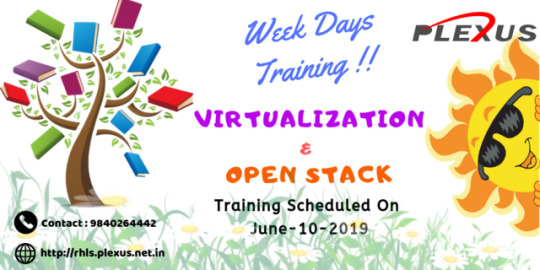
RHLS Certification Subscription Plexus Networks Chennai
#rhls#Red Hat Learning Subscription#RHLS Certification#RHLS Certification in Chennai#rhls course in chennai#rhls certification in plexus#virtualization training in chennai#openstack training in chennai#virtualization training in plexus#openstack training in plexus
1 note
·
View note
Text
the poets and their first summer jobs
i’ve seen some discourse about how rich all the boys/their families are, and of course there would be like very little reason for them to work, but i couldn’t help wondering who would do what for their first jobs (summer jobs bc they couldn’t work while they’re at school). andddd that led me to writing this lol
neil: so neil would have like absolutely zero time for a job between all his normal coursework/extracurriculars and his summer classes (”you know me, always taking on too much”), but i guarantee you he would still take the time to get a job and have his own money to do with whatever he chose. mr. perry wouldn’t care much because it showed neil “taking initiative” or whatever. neil would likely work at a diner as either a bus boy or a waiter. he’s super personable, so he’d always strike up conversations with people sitting at the counter, and he’d get loads of tips bc he’s cute (: he’d bring his summer school work with him to do during lulls in business, which his boss didn’t mind because it’s neil and everyone knows how responsible he is. the poets would come visit him pretty much every day (to eat, see neil, and escape the heat in the air conditioning), likely taking up a whole booth, and making an absolute mess of the area. charlie would be making spitballs, aiming at cameron and knox every time (earning a “charlie, knock it off, i told you three times already! so mature of you, really.” from cameron) and meeks/pitts would try to see how many straws they could connect to make “ultra straw.” todd would come hang out at the counter when neil was closing, admiring his pretty bf as he worked (’: neil would always make todd a chocolate milkshake with whipped cream and rainbow jimmies on the house, claiming, “we have to empty out the ice cream machine anyway” (but really he’d take the cost out of his paycheck, just wanting to make todd happy). his boss would hire him back every summer, loving how much business neil drove in (even if the poets made a mess every time they hung out and ate) and absolutely adoring how much effort neil put into what anyone else would seemingly call a “meaningless” job.
todd: you can’t tell me that todd wouldn’t look forward to working. especially during the summers, it would get him out of the house and away from his parents judging his every move. being the shy introvert he is, he’d likely do things like mowing lawns or gardening for people around his neighborhood. minimal interactions, but still decent pay (as all the people in his neighborhood were likely super rich and could afford to pay him well). the poets’ parents would hire him, after much convincing from their sons (”todd’s just trying to make some money, dad. please?”) and todd would appreciate this more than they ever knew. he’d become super familiar with flower types and he’d become a lot more nurturing after taking care of plants and grass for multiple summers. he’d keep a little journal or notebook with drawings or sketches of the flowers he’d taken care of, complete with descriptions and magazine/newspaper clippings from his mom’s better homes and garden subscription (a lot of his poetry would become nature-related as well). it would be his late night project, or something he’d do if he couldn't sleep (which was pretty common for todd). he’d call neil on the phone some nights and just gush about all kinds of flowers or tell neil how he accidentally got stung by a bee and cried about it because he knew the bee would die (all the while, neil would be listening so intently, taking note about which flowers were todd’s favorites for future use (’: the calls would have to be pretty planned, bc if neil wasn’t working, he was doing school work, or his parents were keeping an annoyingly close watch on him. but sometimes neil would call him impromptu and that made todd just the happiest little camper ever). todd’s nails would be really short (he’d cut them really often because he doesn’t like the feeling of dirt under his nails), which means he couldn’t bite his nails anymore, causing him to pick up a new anxious habit of biting the inside of his bottom lip ): overall, though, todd would like his job, and even find pleasure in being surrounded by little flowers all day. also if/when neil ever got the chance, he’d absolutely tag along to see his sweaty boyfriend in action (come on, neil would go absolutely nuts for todd in a cutoff shirt, 5″ inseam shorts, and converse mowing a lawn looking all manly and tough).
charlie: obviously, charlie wouldn’t need to work because of his financial situation, but his mom would 110% make him get a job just so he wouldn’t be around the house causing trouble/bothering his siblings for fun (”i’m hosting a lot of book club meetings for the country club this summer, i can’t have you putting spiders in the ladies’ hats again, charles”). similar to neil, mr. charlie dalton would work his summers at an ice cream/custard stand. he’d have to wear a white, short sleeve button up, a red and white striped apron, and one of those white, rectangular hats (his least favorite part HAHA, stating, “my hair is one of my best features and this just takes it all away. it’s unfair.”). the poets would visit often, both for ice cream, but primarily to give him a hard time about his uniform (”i’ll give you twenty bucks to wear this on our first day of classes” meeks would tease, completely gobsmacked when charlie showed up to their first chemistry class in his uniform, earning lots of demerits, but also twenty dollars). charlie would hate it at first, but obviously he’d adjust, being the extroverted/personable person, not taking himself too seriously and being one of the best ice cream slingers anyone had ever seen. he’d give the cute girls (and boys) extra scoops of ice cream for free, winking as he handed them their orders. like neil’s boss, charlie’s boss was even more thankful for charlie’s presence because they’d likely be raking in at least triple the income they would in a summer without him. he’d become a sundae expert, spending many dead poets meeting making them for his friends while they read poems and stories. that being said, he’d come to hate eating ice cream, publishing an article in welton’s honor demanding that they remove ice cream from their dessert menu (yes, almost exactly like the “girls at welton” prank, but he’d make the call collect this time. mr. nolan would be fed up to the point where he wouldn’t even punish charlie physically, just suspend him from rowing [which charlie wouldn’t mind at all HAHA]).
meeks & pitts: after their hi-fi success and the fact that they are seemingly inseparable, they both sought out jobs at the local radio station where they were hired as interns/assistants, running errands and picking up coffee or lunch for the station. but sometimes, when they worked pretty late, the night shift dj would let them pick the records and show them how everything worked (: after nights like that, meeks and pitts would go to one of their houses and add modifications to their hi-fi radio, staying up all night modifying and researching (by the end of the summer, they had made another hi-fi (portable) and their og hi-fi would have been morphed into a huge nationally reaching radio that they keep in the cave (since it would be disallowed in their room at welton). another job that the two of them would have would be answering calls for the station about song requests. with this knowledge, charlie and the other poets would hang out at someone’s house, calling and requesting the same songs over and over and over again. their biggest task for the summer would be organizing the shelves with all the records into alphabetical order (”duh, we should go by first name, meeks. which other way would it be” pitts would argue, only to find out that after they had spent about three weeks alphabetizing by first name, they were supposed to go by last name. “now who’s the idiot?” meeks would jeer, beginning to pull the records off the shelves). they’d also learn a lot about music from their night shift coworker, which would help in their quest to woo some ladies the following school year.
cameron: cameron liked spending his summers doing research projects for fun and just reading a whole lot, so you can imagine his displeasure at when his parents asked him to get a job (presumably to help with paying for his schooling). while upset about it, he wouldn’t complain, and took it on the chin, understanding the reasoning. he’d apply to a couple places, but ultimately end up as a grocery store cashier/stock boy. much like charlie, he’d have the same kind of uniform, but with a green apron instead. he’d spend most of his shift ringing people up at the register, being friendly and personable (something no one ever really realized about him !!). the poets’ moms would always see him and choose his register on purpose, using it as a chance to catch up or tell him to tell his parents that “the overstreets say hello!” or “mrs. anderson says hi!” pitts, meeks, and charlie would utilize cameron’s position at the supermarket to buy nudie magazines unembarrassed/slightly illegally HAHA (”come on, cameron! it’s not like you won’t be included in seeing them next year, too. we bring them to the meetings, you know that!” charlie would say, leaving cameron at a loss, reluctantly scanning the magazines and bagging them as pitts and meeks sniggered). charlie would wave, blow him a kiss, and wink as they left, “love you, richardddd.” sure enough, the magazines would make an appearance during the following school year and cameron was glad he had decided to let them buy the magazines lol.
knox: out of all the poets, i feel like our knoxious would be the least inclined to work (yes, even less inclined than charlie). his parents wouldn’t even make him get a job because he simply didn’t need to, but to everyone’s surprise, he would volunteer at the animal shelter. the poets would later find out that it was a great way to meet girls (which is why he did it lmfao so they endlessly goaded him about it). charlie would visit often, and even took a rescue puppy home, much to charlie’s younger sister’s delight. charlie even wanted to start volunteering at the shelter to also meet girls, but he was too busy at the ice cream stand (plus, he had really grown to like it there so he didn’t want to leave). another effect of volunteering made knox super interested in zoology and animals, which brought out a newer, more nurturing/caring side to him, and who knows, maybe he’d go vegetarian somehow. he’d want to pursue a career in animal science or becoming a veterinarian, but mr. overstreet was hellbent on knox taking over the firm, so it seemed like a pipe dream. knox would continue to volunteer at the animal shelter, well into his career as a lawyer, and would even go to veterinary school in his 30s (when he was a nationally famous, established lawyer) to get certification to work with animals in a broader way (:
hope you guys liked these. it was pretty fun to write, and i'd pay such good money to see neil, charlie, and cameron in their uniforms (and todd, but that’s neither here nor there). happy thursday !! let me know what you guys think of these <3(:
#dead poets society#dead poets in nyc#dps#dps headcanons#neil perry#todd anderson#anderperry#neil and todd#charlie dalton#richard cameron#steven meeks#gerard pitts#dark academia#headcanon#angelina writes
112 notes
·
View notes
Text
🖥️ Red Hat OpenStack Administration I: Core Operations for Domain Operators (CL110)
Cloud computing is rapidly evolving, and businesses need flexible, scalable infrastructure to stay competitive. OpenStack—an open-source cloud platform—is at the heart of this transformation. To effectively manage cloud operations and services, IT professionals need more than theoretical knowledge—they need real, hands-on skills.
That’s where Red Hat OpenStack Administration I (CL110) comes in.
In this blog, we’ll explore what this course offers, who it’s for, and why it’s an essential step for any IT administrator or cloud operator managing Red Hat OpenStack Platform.
🌐 What Is Red Hat OpenStack?
Red Hat OpenStack Platform is an enterprise-ready cloud platform built on the open-source OpenStack project. It provides:
Scalable infrastructure for running virtual machines, containers, and bare-metal servers
APIs for automating cloud services
Integration with storage, networking, and identity services
Full support and lifecycle management from Red Hat
Here are the key areas:
🔧 1. Cloud Architecture Overview
Understand the components of OpenStack: Nova (compute), Neutron (networking), Cinder (block storage), Glance (images), and more
Learn how OpenStack interacts with users, tenants, and domains
☁️ 2. Managing Projects and Users
Create projects, users, and assign roles
Work with Keystone (identity service) for access control
🖥️ 3. Provisioning Instances
Launch and manage virtual machines using Horizon (GUI) and CLI
Use flavors, key pairs, security groups, and floating IPs
🧰 4. Storage Management
Attach and manage Cinder block storage
Use Glance to manage image libraries
🔌 5. Networking with Neutron
Understand network types: provider vs. self-service
Create networks, routers, and connect instances to the internet
📈 6. Monitoring and Troubleshooting
Monitor instance status, logs, and quotas
Troubleshoot common issues with instance provisioning and networking
👤 Who Should Take This Course?
This course is ideal for:
Cloud domain operators who manage daily cloud tasks
System administrators working with OpenStack-based environments
DevOps engineers needing to automate and scale infrastructure
Anyone preparing for the Red Hat Certified OpenStack Administrator (RHCOSA) certification
🎯 Why This Course Matters
✅ Hands-On Training: Work in a real OpenStack lab environment ✅ Job-Ready Skills: Get equipped to manage OpenStack clouds at scale ✅ Enterprise Relevance: OpenStack powers private clouds in telecom, finance, and government sectors ✅ Certification Path: Prepares you for advanced OpenStack courses and certification
🧠 What’s Next After CL110?
After completing Red Hat OpenStack Administration I, learners often move on to:
➡️ CL210 – Red Hat OpenStack Administration II ➡️ Red Hat Certified Specialist in Cloud Infrastructure
This progression deepens knowledge in automation, orchestration (Heat), and advanced network configuration.
📌 Final Thoughts
Red Hat OpenStack Administration I (CL110) is the perfect starting point for those looking to work confidently in an OpenStack-powered private cloud. With hybrid cloud strategies gaining momentum, mastering OpenStack operations gives you a competitive edge in IT infrastructure management.
Ready to dive into the world of OpenStack? Join our next batch or access the course through the Red Hat Learning Subscription (RHLS). Learn from certified instructors, access live labs, and build your cloud career today.
🔗 Visit hawkstack technology to get started.
0 notes
Text
red hat learning subscription

0 notes
Text
Mastering Advanced Cluster Management with Red Hat OpenShift Administration III (DO380)
In today’s hybrid cloud era, managing container platforms efficiently at scale is mission-critical for modern enterprises. Enter Red Hat OpenShift Administration III: Scaling Kubernetes Deployments in the Enterprise (DO380) — a course designed for experienced OpenShift administrators who want to take their skills to the next level.
🧠 What Is DO380?
DO380 is the third level in the OpenShift administration curriculum. It focuses on advanced operational techniques for Red Hat OpenShift Container Platform, including:
Multi-cluster management with Red Hat Advanced Cluster Management (RHACM)
Advanced configuration of OpenShift networking
Advanced security and compliance management
Performance tuning and cluster health monitoring
Managing OpenShift at scale
This course is ideal for administrators who’ve already completed DO280 (Red Hat OpenShift Administration II) and are looking to manage large-scale, complex, and distributed OpenShift environments.
🛠️ Key Skills You’ll Learn
By the end of the DO380 course, you’ll be able to:
✅ Use Red Hat Advanced Cluster Management (RHACM) to manage multiple OpenShift clusters
✅ Centralize policy-based governance and security at scale
✅ Optimize OpenShift clusters for performance and efficiency
✅ Troubleshoot and recover from cluster-level issues
✅ Implement observability and metrics using Prometheus and Grafana
✅ Apply best practices for cluster security and compliance (CIS Benchmarks, SCAP, etc.)
📦 What’s Included in the Course?
Instructor-led or self-paced training (via Red Hat Learning Subscription)
Hands-on labs with real-world scenarios
Access to Red Hat Academy (if you're a student or partner)
Certification path: Prepares for EX380 (Red Hat Certified Specialist in OpenShift Administration III)
🎓 Who Should Take DO380?
This course is designed for:
System administrators managing OpenShift clusters in production
DevOps engineers scaling containerized applications
IT operations professionals responsible for platform governance
RHCSA or RHCE holders expanding their OpenShift capabilities
🧭 Prerequisites
You should have:
A Red Hat Certified System Administrator (RHCSA) in Red Hat OpenShift or equivalent experience
Completed DO280 (Red Hat OpenShift Administration II)
🏆 Why It Matters
Kubernetes is powerful, but managing it in enterprise environments can be overwhelming. Red Hat OpenShift simplifies Kubernetes — and DO380 teaches you how to scale, secure, and manage it like a pro.
Whether you're working in a hybrid cloud or multi-cloud environment, DO380 equips you with the tools to operate with confidence and precision.
📌 Final Thoughts
The Red Hat OpenShift Administration III (DO380) course is essential for professionals who want to own their OpenShift environments end-to-end. If you're ready to handle the challenges of scaling and managing OpenShift clusters at the enterprise level, this course is your next big step.
Ready to level up your OpenShift game?
Enroll in DO380 and become an expert in managing Kubernetes at scale with Red Hat OpenShift.
🔗 Interested in training for your team?
We offer corporate packages and Red Hat Learning Subscription (RHLS) options — www.hawkstack.com
0 notes
Text
Bringing Evil Hat to Roll20
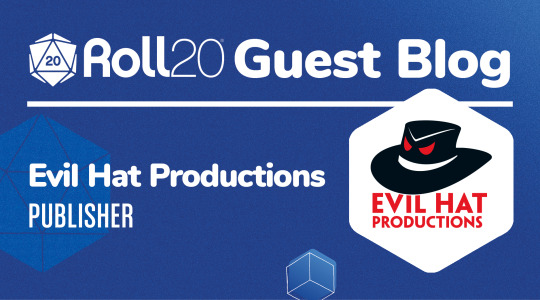
The games we make are inherently social. For The Queen is a GM-less game where the players build and discover the story together. Blades In The Dark stars a crew of flawed scoundrels chasing their fortunes on the grimy streets of a haunted metropolis. In Monster of the Week, the players work as a team to track down cryptids and other supernatural threats. These are all games about imagination, drama, suspense, and connecting through a shared story.
But for many people, the pandemic took a hobby they enjoyed around a shared table with friends and sent them scrambling for ways to find that same rich, engaging experience online. Up to that point, we mostly published hardcopy books and PDFs. We needed a new and better way to reach our fans.
Roll20 offers an established user base, strong Marketplace, and browser-based platform which makes it easy to access. But most of all, we’ve been able to do some things on Roll20 which, frankly, we’re not sure we could do on other platforms.
For starters, we’ve dramatically enhanced the Fate character sheet to offer a high degree of customization, with swappable stats for shapeshifting characters, rollable aspects, advanced extras, and much more. These features are available to anyone, no matter what their subscription level or budget. There’s a lot of power there, and it’s free.
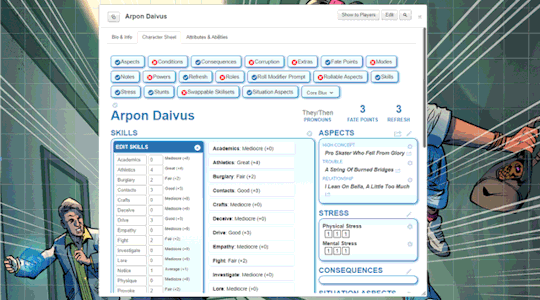
Similarly, we’ve improved the Monster of the Week character sheet so it allows you to pick any Move from any character Playbook, hide the Moves you're not using, and quickly reference rules without having to click between a bunch of handouts.
We’ve been able to leverage our terrific art assets to make sure everything we release has a complete set of high quality tokens for both the GM and players. It really makes a game like Tachyon Squadron - where tokens are key to maneuvering through dogfights - both easy to run and more immersive.

For games with an epic scope, like Fate of Cthulhu or Band of Blades, we’ve created campaign-wide tracking playmats to help you nail down the details across sessions of play. In Scum and Villainy, we’ve set up a handy quick-reference page which allows you to track your crew’s Heat and Wanted status for every system in the Procyon Sector.
Depending on what kind of trouble your crew gets into on the bloody, muddy streets of Doskvol, it can get tricky to track things like crew and faction status in Blades in the Dark. Roll20’s custom token markers provide an efficient visual flag, so you can tell at a glance how you’re faring against the Dimmer Sisters or the Red Sashes.

And in many modules such as the Monster of the Week mysteries, we’ve designed customizable clocks, trackers, and even page backdrops which the GM can swap in and out as the adventure unfolds.

When the pandemic started, we had just three offerings on Roll20. Now we have over 50. We wouldn’t have been able to do that without Roll20’s powerful engine and their ability to quickly review and deploy changes. By offering ready-made PCs, thoroughly linked handouts, and a set of flexible character sheets and tokens, we’re confident we’re not just offering a great “pick up and play” experience; we’re offering a way to game that, in many respects, is better than pushing paper.
We don’t know when we’ll all be able to gather around a kitchen table again and roll dice together. 2020 has a knack for being unpredictable. But one thing is for sure: We’re going to continue developing on this platform and help people connect, relax, inspire each other, and share the escape of imagination. Follow the Evil Hat Crew on Twitter. Sean Nitter, Director of Projects Sophie Lagacé, Project Manager Tom Lommel, Marketing Director As a reminder, we’re matching donations to Code2040, “a nonprofit activating, connecting and mobilizing the largest racial equity community in tech to dismantle the structural barriers that prevent the full participation and leadership of Black and Latinx technologists in the innovation economy.” Learn more and donate through our Tiltify campaign here: https://tiltify.com/+roll20/roll20-community
9 notes
·
View notes
Text
Red Hat Training Overview
Red Hat training provides hands-on, lab-based instruction across a wide range of topics, including system administration, cloud computing, DevOps, and more. The training is designed to help individuals and teams improve their productivity, enhance their skills, and stay current with the latest technologies.
Popular Red Hat Course
Red Hat System Administration I (RH124)
Description: This course is designed for IT professionals without previous Linux system administration experience. It covers basic command-line skills, managing physical storage, and installing and configuring software components and services.
Key Topics:
Introduction to the command line
Managing files from the command line
Getting help in Red Hat Enterprise Linux
Creating, viewing, and editing text files
Managing local users and groups
Red Hat System Administration II (RH134)
Description: This course is intended for IT professionals who have completed Red Hat System Administration I and introduces key tasks needed to become a full-time Linux administrator.
Key Topics:
Automating installation with Kickstart
Managing filesystems and logical volumes
Managing scheduled jobs
Accessing network filesystems
Managing security with firewall and SELinux
Red Hat Certified Engineer (RHCE)
Description: This course is for experienced Linux administrators who need networking and security skills to manage Red Hat Enterprise Linux servers. It also prepares for the RHCE certification exam.
Key Topics:
Configuring static routes, packet filtering, and network address translation
Configuring an Internet Small Computer System Interface (iSCSI) initiator
Producing and delivering reports on system utilization
Using shell scripting to automate system maintenance tasks
Configuring system logging, including remote logging
Red Hat OpenShift Administration I (DO280)
Description: This course is designed for system administrators, architects, and developers who want to install, configure, and manage OpenShift clusters.
Key Topics:
Installing OpenShift Container Platform
Configuring and managing OpenShift clusters
Creating and managing containerized services
Managing users and policies
Securing OpenShift applications
Red Hat Certifications
Red Hat Certified System Administrator (RHCSA)
Exam Code: EX200
Description: Validates the knowledge and skills required of a system administrator responsible for Red Hat Enterprise Linux systems.
Exam Format: Hands-on, practical exam
Red Hat Certified Engineer (RHCE)
Exam Code: EX294
Description: Builds on the RHCSA certification and demonstrates advanced knowledge and skills required of senior system administrators.
Exam Format: Hands-on, practical exam
Red Hat Certified Specialist in OpenShift Administration
Exam Code: EX280
Description: Validates skills and knowledge to create, configure, and manage a cloud application platform using Red Hat OpenShift.
Exam Format: Hands-on, practical exam
Training Methods
Classroom Training
Instructor-led training conducted in a physical classroom environment.
Virtual Training
Instructor-led training delivered online in a virtual classroom.
On-Demand Training
Self-paced online training that provides flexibility to learn at your own pace.
Red Hat Learning Subscription
A subscription-based service that provides access to all Red Hat Online Learning courses, video classroom courses, and early access content.
Benefits of Red Hat Training
Hands-On Experience: Training includes practical, real-world tasks to build competency.
Certification Preparation: Courses are designed to prepare you for Red Hat certification exams.
Updated Curriculum: Content is regularly updated to align with the latest technology and industry trends.
Expert Instructors: Courses are taught by certified Red Hat instructors with extensive industry experience.
Getting Started
To get started with Red Hat training, visit the Red Hat Training and Certification website. You can browse courses, find a training location, and register for classes or exams.
This should give you a comprehensive overview of Red Hat training. If you have any specific questions or need more detailed information on a particular course or certification, feel free to ask!
For more details click www.qcsdclabs.com
#linux#docker#information technology#redhatcourses#containerorchestration#containersecurity#aws#kubernetes#container#dockerswarm
0 notes
Text

"Elevate Your Skills: RHLS for IT Excellence - Unlock Your Potential: Red Hat Learning Subscription" Where knowledge meets opportunity Visit: https://amritahyd.org/ Enroll Now- 90005 80570
#AmritaTechnologies #amrita #rhls #rhls2020 #LinuxUnleashed #LimitlessPossibilities #OpenSourceInnovation #LinuxEmpowers #InfiniteHorizons#
0 notes
Text
Skeleton Gift Lists
I originally wrote this for Gyftmas last December, but it applies at any time. If you want to give a skellie a gift, this is what they like! (I’ve added the Dancetale boys to this list.)
Sans - handmade anything (you made that for him? he is immediately touched and will keep it forever); space/galaxy things, comfy stuff, socks
Papyrus - superhero things (he likes all of them; you can’t go wrong); action figures; puzzle books/games
Blue (US Sans) - things he can build (legos, jigsaw puzzles, etc.), kids books for his school kiddos, promise to spend some time with him, fun new sprinkles or other food-related things
Stretch (US Papyrus) - pens and paper and notebooks (he is a writer, after all); books; anything sweet
Red (UF Sans) - things he can take apart and rebuild; classic video games; comic books; cool technology; anything chocolate
Boss (UF Papyrus) - scarves; things for Doomfanger; things to help him stay organized (planners, journals, desktop organizer thingies, etc.)
Black (SF Sans) - books (particularly nice versions of classic novels); things for his dogs (treats, toys, etc.); nice coffee
Mutt (SF Papyrus) - art supplies; plushies; anything soft and cozy (blankets, pillows, hoodies, etc.)
Sansy (HT Sans) - anything edible, especially if you made it yourself; stuff for Hope; joke books; comfy things (shirts, hoodies, blankets, socks)
Sweets (HT Papyrus) - cookbooks, cooking related stuff (new mixing bowls, cookie cutters, etc.), food (especially if you made it yourself); puzzles or puzzle building things
Bones (MT Sans) - joke gifts; stuff for his bro; spend time with him, help with new technology, hats
Lucky (MT Papyrus) - music (sheet music he could play, CDs, a subscription to a streaming service...), handmade anything
Smiley (MF Sans) - anything sweet; spend time with him, hugs and cuddles and love, human magic tricks (card tricks, sleight of hand)
Grim (MF Papyrus) - photography related things; DVDs or Blu-ray versions of films (especially with lots of behind the scenes features); 3D jigsaw puzzles
G (G!Sans) - mystery/detective novels; snacks (salty or sweet); fidget toys or puzzle toys (i.e. rubik’s cube); little keychains
Aster (G!Papyrus) - puzzles; notebooks/planners, pens; nice mugs and tea
Comet (OT Sans) - PLANTS AND PLANT RELATED STUFF (potted plant, seeds, bulbs, pots to plant things in, books about plants,etc.), science books in general
Captain (OT Papyrus) - cool outfits and accessories; puzzles, puzzle books, or puzzle building stuff; plushies (especially animal ones); comic books or graphic novels (he’d really like to learn about Earth culture!)
Break (DT Sans) - comfy things (shirts, hoodies, blankets, socks), spend time with him
Tango (DT Papyrus) - new clothes, dance with him, anything music-related
Honestly, the fellas would be thrilled with anything you guys give them. There’s also a lot of overlap. A lot of the Sanses would love joke books or science stuff. A lot of the Papyri would love puzzles or puzzle building stuff. And frankly, the best gift you could give any of them is your company. They love just spending time with you! You guys are awesome!
40 notes
·
View notes